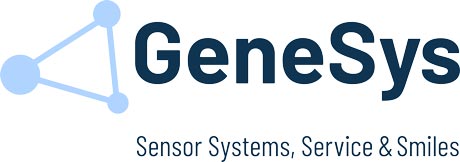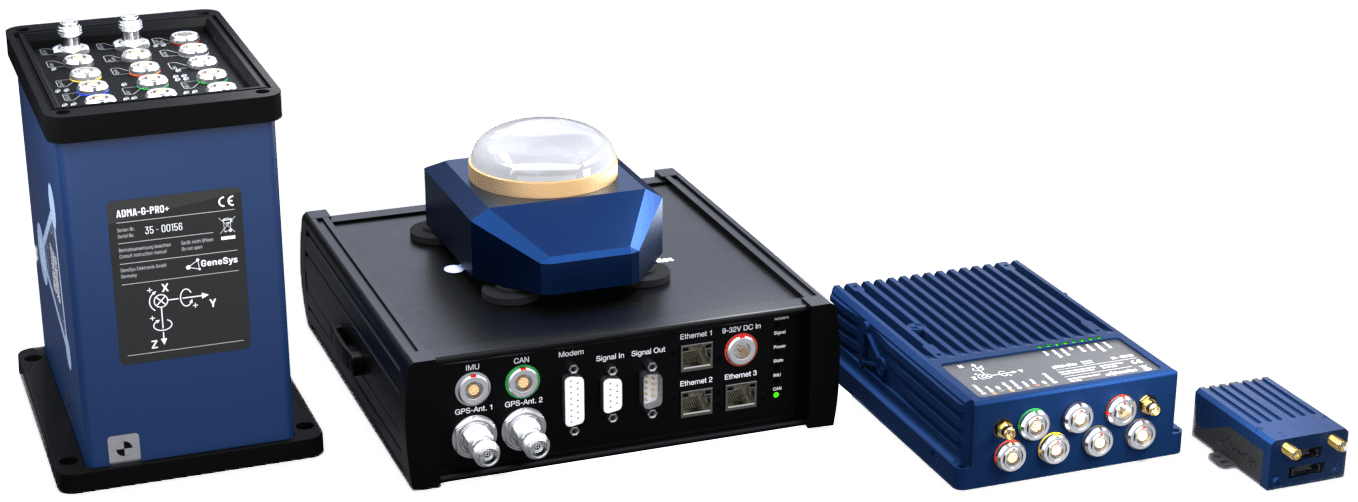Meet new measurement and testing requirements with our ADMA Add-Ons and Options
The new generation of ADMA3.5 devices now allows our customers to meet their new and changing needs. Our focus is on straightforward use and increased productivity.
The Add-Ons and Options can be activated quickly and conveniently by entering a license key. This is possible at any time without modifications to the hardware. A high degree of flexibility is thus ensured.
Overview ADMA Add-Ons and Options
- Add-On BRAKING: Real-time calculation of brake performance data according to international regulations
- Add-On DELTA 1:5: Relative data calculation via WiFi in real-time for multi-vehicle operation
- Add-On FILTER: Option for online signal filtering
- Add-On LATDEV: Real-time calculation of the lateral deviation
- Add-On gPTP: Time synchronization with generalized Precision Time Protocol (gPTP)
- Add-On Smoothing: Define maximum step size for GNSS signal
- Option 1kHz: Data output rate of 500 Hz and 1 kHz via CAN or Ethernet interface
- Option DGNSS Correction Data: Correction data reception via Ethernet
- Option Dual-Ant: Two GNSS antennas option
- Option Full-INS: For the full range of functions with all output values as with an ADMA inertial system.
- Option GNSS-Raw Data: Raw data output via Ethernet for post-processing
- Option Internal Memory: Storing ADMA measurement data in internal memory
- Option Multi-CAN: Data output via several CAN channels simultaneously
- Option Multi-GNSS: Use of multiple satellite systems such as GPS, GLONASS, Galileo, Beidou
- Option RTK2: High-precision position measurement using correction data
- Option Vehicle Model: 2D vehicle model predicts vehicle behavior, supports IMU & adapts to conditions
Click scrolls to selected option

Add-On BRAKING: Real-time calculation of brake performance data according to international regulations

The Add-On ”Braking” is the sophisticated solution for brake performance measurement. Enabling brake pedal triggered as well as velocity threshold triggered measurement, all relevant parameters, including mean deceleration, brake distance and trigger speed are provided. Both full brake and fading test are supported.
- Product code for inquiries:
ADMA-OPT-BRAKING - For ADMA-Speed it is included, even in the basic version
Add-On DELTA 1:5 : Relative data calculation via WiFi in real-time for multi-vehicle operation

The ”DELTA” Add-On enables the direct output of relative data (distance, velocities, angles) between up to five vehicles. Other than a WiFi connection between the ADMAs, no additional hardware is required.
Data is provided in real time with minimum latency. This option is widely used for ADAS tests, especially AEB, FCW and ACC. Our customers rely on the ADMA option both when establishing a precise distance reference and for distance control of steering robots.
- Product code for inquiries:
ADMA-OPT-DELTA


Add-On FILTER: Option for online signal filtering

The Filter add-on allows different filter settings to be applied to the output ADMA acceleration and angular rate data.
- Product code for inquiries:
ADMA-OPT-FILTER
Add-On LATDEV: Real-time calculation of the lateral deviation

The Add-On LATDEV is used to test and validate Lane Departure Warning (LDW/LSS) systems. It calculates in real time the distance to two predefined straight lines, a fixed object, the angle to the straight lines, the lateral speed and acceleration in relation to three user-defined POIs (Point of Interests).
- Product code for inquiries:
ADMA-OPT-LATDEV


Add-On gPTP: Time synchronization

The generalized Precision Time Protocol (gPTP) spezifed as IEEE802.1AS is an advancement of the Precision Time Protocol (PTP) spezifed as IEEE 1588 and is used for precise synchronization of timestamps in Time Sensitive Networks (TSN). It enables accurate time coordination between different devices in a network with exceptionally high precision in the microsecond range. This precision is crucial for applications that require an exact time reference, such as those found in vehicle development for synchronized data capture and analysis.
The Add-On gPTP encompasses the functionalities, 2-Step and P2P. Moreover, the ADMA can operate as a gPTP Master within the gPTP network, allowing them to take a central role in maintaining synchronization. By integrating these advanced synchronization features, customers can achieve enhanced performance and reliability in their applications.
- Product code for inquiries:
ADMA-OPT-gPTP
Add-On Smoothing: Define maximum step size for GNSS signal

The new feature allows users to set a maximum step size for GNSS control. This means that if the GNSS data jumps, for example due to poor GNSS conditions, the INS data in the selected POI will be approximated to the GNSS data by the maximum step size selected. Smoothing is available for INS Position, INS Velocity and Side Slip Angle in each POI and in the Robot Data output.
In addition, if the difference between the smoothing result and the GNSS data lasts longer than expected due to a very large jump, the measurement data will be reset to the unaffected values after a user-defined amount of time. Overall, this feature provides greater control and accuracy in the handling of GNSS and INS data.
- Product code for inquiries:
ADMA-OPT-SMOOTHING


Option 1 kHz: Data output rate of 500 Hz and 1 kHz via CAN or Ethernet interface

By means of a 1kHz license, the ADMA measurement data can be output with an update rate of 500 Hz and even 1000 Hz via Ethernet and CAN.
- Product code for inquiries:
ADMA-OPT-1KHZ
Option DGNSS Correction Data: Correction Data reception via Ethernet

The “DGNSS” option provides the capability to receive DGNSS correction data forwarded from a second ADMA via WiFi. This is the preferred option for multi-vehicle applications, e.g., ACC, AEB and FCW testing.
This option is used in place of radio modems, increasing the availability of DGNSS correction data, especially on public roads.
- Product code for inquiries:
ADMA-OPT-DGPS


Option Dual-Ant: Two GNSS antenna option

The Dual-Ant option provides heading angle detection without initialization and control at very slow speeds. Among other things, this option is helpful when using robotic systems where a valid heading angle is needed right at the beginning.
- Product codes:
ADMA-OPT-DUAL-ANTADMA-SLIM-OPT-DUAL-ANTADMA-SPEED-OPT-DUAL-ANT - Note: Only available in combination with RTK2 activation and dual antenna capable GNSS receiver
Option Full-INS: License for the full range of ADMA functions

For the full range of functions with all output values as with an ADMA inertial system.
With the help of the Full-INS license option you can upgrade your ADMA-Speed, which is dedicated for brake distance measurements, to full ADMA functionality. This unlocks the ADMANet data output and makes it possible to use further options such as Addon-DELTA or Addon-Filter.
- Product code for inquiries:
ADMA-SPEED-OPT-FULL-INS


Option GNSS-Raw Data: Raw data output via Ethernet for post-processing

The GNSS-Raw Data option, like all of our feature enhancements, can be easily activated later without changing the hardware. With the option you get access to the recorded GNSS raw data via the Ethernet interface and can significantly increase the GNSS accuracy in post-processing applications e.g. with our Post-Processing Software ADMA-PP.
Data logging is user-friendly with the free GeneSys Ethernet Logger software.
- Product code for inquiries:
ADMA-OPT-GPS-RAW - The GNSS Raw Data option is available for all ADMA models
- Note: Separate WLAN router and Ethernet cable are required
Option Internal Memory

The option “Internal Memory” provides a solution for local storage of measurement data and configuration files on the ADMA. This makes it possible to dispense with a DAQ (Data Acquisition) device in certain situations. This has the advantage of significantly reducing the effort, time and complexity of the setup, since no further configuration steps are required for data recording and fewer hardware components are needed.
Raw measurement data is stored in internal memory in binary format. This raw data format is seamlessly integrated into the entire GeneSys toolchain, which allows the data to be conveniently analyzed, compared or further processed in the ADMA Data Analyzer after the measurement. Functions such as offline delta calculation using the Moving Base software or optimization using the Post-Processing Software ADMA-PP are available for this purpose.
Another significant improvement is the simpler and more consistent management of configurations. Different configurations for different applications and scenarios can be stored locally in the internal memory and recalled when needed. This facilitates handling and ensures a consistent way of working when configuring the ADMA.


Option Multi-CAN: Data output via several CAN channels simultaneously

Allows to split the CAN data stream to up to 5 CAN interfaces to provide more measurement data at higher data output rate.
- Product code for inquiries:
ADMA-OPT-MULTI-CAN - Note: Separate CAN-2-5 cable is required
- Not available for ADMA-SPEED and ADMA-Slim
Option Multi-GNSS: Use of multiple satellite systems such as GPS, GLONASS, Galileo, Beidou

Today’s GNSS-Receivers have the option of accessing multiple satellite systems such as GPS, GLONASS, Galileo and Beidou.
By using these systems in addition to GPS the Receiver is able to track more Satellites which results in the following advantages:
- Product code for inquiries:
ADMA-OPT-GALILEOADMA-OPT-GALILEO-BEIDOUADMA-OPT-BEIDOUADMA-OPT-GLONASS - Reduced signal acquisition time.
- Improved position and timing accuracy.
- Reduction of problems caused by obstacles such as buildings and leaves
- Improved spatial distribution of visible satellites, resulting in improved position accuracy.


Option RTK2: High-precision position measurement using correction data

RTK stands for Real-Time Kinematic and is a technique based on carrier-based distance measurement that can determine positions with high precision. The method is much more accurate than code-based location. The basic concept is to eliminate the various error sources of raw GNSS positioning by using a local base station whose exact position is known. For this purpose, correction data of a virtual base station of different correction data services can be requested, or a local base station with its own GNSS receiver is used.
- Product code for inquiries:
ADMA-G-PRO+RTK2ADMA-G-ECO+RTK2ADMA-G-ECO-RTK2ADMA-SLIM-RTK2ADMA-SLIM-RTK2-SCADMA-SLIM-RTK2-OEMADMA-SLIM-RTK2-OEM-OFADMA-SPEED-OPT-RTK2
Option Vehicle Model

The 2D vehicle model is an important tool for describing the motion of a vehicle in an XY plane. It is used internally to predict the behavior of the vehicle under different conditions and thus to support the IMU (Inertial Measurement Unit). In situations where GNSS failures are likely, e.g. city driving or in tunnels, it is advisable to use external speed sensors to support the inertial data. If this is not possible, an adaptive vehicle model can be activated that continuously estimates model parameters during good reception conditions without affecting the inertial data.
In case of GNSS outage, the estimated parameters of the adaptive vehicle model can be used to reduce the lateral drift of velocity and position and improve the quality of yaw and slip angle. However, it is important to note that the use of the 2D vehicle model is only beneficial for passenger cars; in fact, this feature may be detrimental for other vehicles. Therefore, it is important to carefully consider and evaluate the application of the model to achieve the best results.






